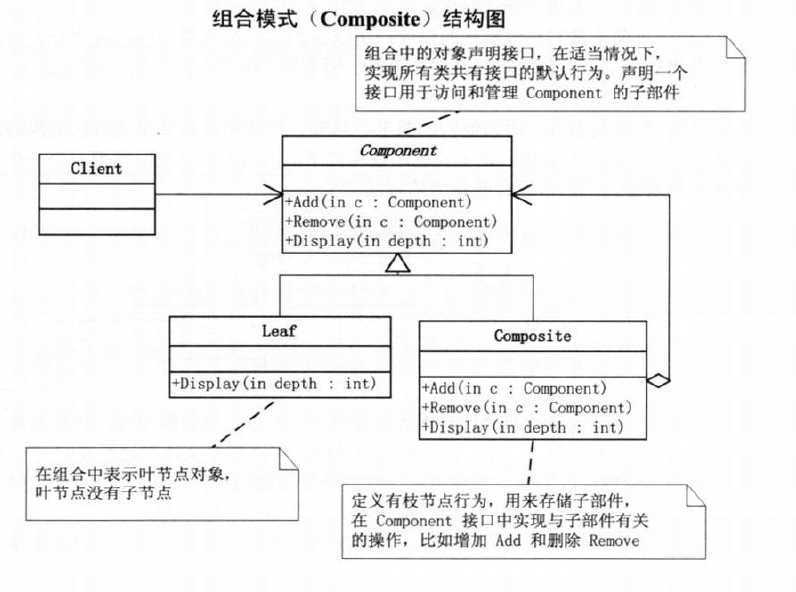标签:
设计模式之第22章-组合模式(Java实现)
“鱼哥,有没有什么模式是用来处理树形的“部分与整体”的层次结构的啊。”“当然”“没有?”“有啊。别急,一会人就到了。”
组合模式之自我介绍
“请问你是?怎么什么都不说就直接上来了。”“本式行不更名坐不改姓,就是组合模式来着,此次受作者之邀来讲讲我的前世今生来着。”“哦,你就是组合模式啊,久仰久仰。”“失敬失敬。”恩,首先我先说下定义:Compose objects into tree structure to represent part-whole hierarchies.Composite lets clients treat individual objects and compositions of objects uniformly.就是说将对象组合成树形结构以表示“部分-整体”的层次结构,使得用户对单个对象和组合的使用具有一致性。我的通用类图如下所示:

用户使用Component类接口与组合结构中的对象进行交互。如果接收者是一个叶节点,则直接处理请求,如果接收者是Composite,它通常将请求发送给它的子部件,在转发请求之前与/或之后可能执行一些辅助操作。
组合模式之自我分析
优点:
缺点:
组合模式之实现
实现这么简单的事还需要举栗子么?(PS:别废话,这个东西是赖不掉的,想当年工厂方法和抽象工厂夫妻俩就没赖掉。)那个好吧,我就举个栗子以便于理解:
首先是抽象的Component类:
1 public abstract class Component{ 2 //部分与整体共享的方法 3 public void doSth(){ 4 5 } 6 }
接下来是继承自树枝的类的实现,里面包含增加、删除以及获得分支下所有的叶子或分支组件的方法,代码如下:

1 public class Composite extends Component{ 2 //Component容器 3 private ArrayList<Component> compList = new ArrayList<>(); 4 //增加叶子/树枝节点 5 public void add (Component component){ 6 this.compList.add(component); 7 } 8 9 //删除叶子/树枝节点 10 public void remove(Component component){ 11 this.compList.remove(component); 12 } 13 14 //获得分支下所有的叶子/分支Component 15 public ArrayList<Component> getChildren(){ 16 return this.compList; 17 } 18 }
叶子节点的实现方法:
1 public class Leaf extends Component{ 2 3 }
组合模式就这么简单的实现了。为表诚意,我再实现个场景类来说明如何调用这些个方法:

1 public class Client{ 2 public static void main(String[] args) { 3 //创建根节点 4 Composite root = new Composite(); 5 root.doSth(); 6 //创建一个树枝 7 Composite branch = new Composite(); 8 //创造叶子 9 Leaf leaf = new Leaf(); 10 //组合 11 root.add(branch); 12 branch.add(leaf); 13 } 14 }
此类中,显示创建根节点,然后是树枝,最后是叶子,然后这些被组合成树。就此结束。
组合模式之应用场景
好了,设计模式之23式至此完结。撒花,撤走~撒有那拉,米娜。
PS:本博客欢迎转发,但请注明博客地址及作者~
博客地址:http://www.cnblogs.com/voidy/
博客新址:http://voidy.net
<。)#)))≦
标签:
原文地址:http://www.cnblogs.com/voidy/p/4264040.html